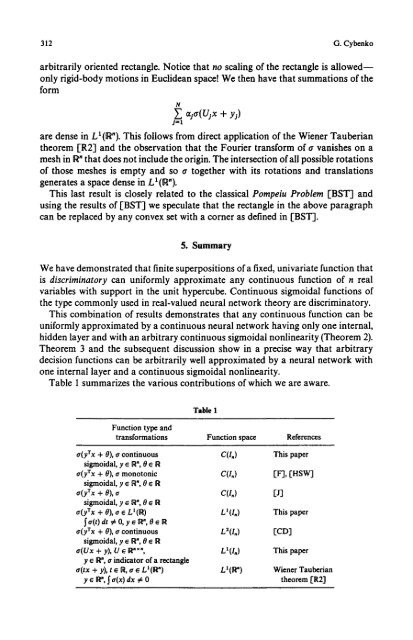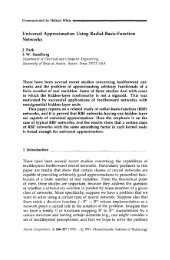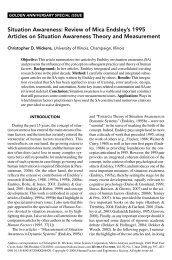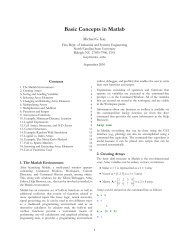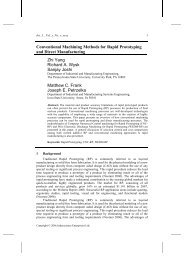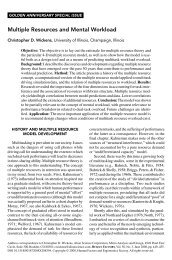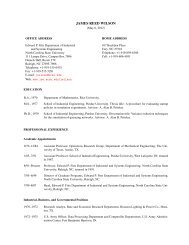Approximation by superpositions of a sigmoidal function
Approximation by superpositions of a sigmoidal function
Approximation by superpositions of a sigmoidal function
You also want an ePaper? Increase the reach of your titles
YUMPU automatically turns print PDFs into web optimized ePapers that Google loves.
312 G. Cybenko<br />
arbitrarily oriented rectangle. Notice that no scaling <strong>of</strong> the rectangle is allowed--<br />
only rigid-body motions in Euclidean space! We then have that summations <strong>of</strong> the<br />
form<br />
N<br />
j=t<br />
~ja(Ujx + y~)<br />
are dense in LI(R"). This follows from direct application <strong>of</strong> the Wiener Tauberian<br />
theorem [R2] and the observation that the Fourier transform <strong>of</strong> a vanishes on a<br />
mesh in R" that does not include the origin. The intersection <strong>of</strong> all possible rotations<br />
<strong>of</strong> those meshes is empty and so a together with its rotations and translations<br />
generates a space dense in LI(Rn).<br />
This last result is closely related to the classical Pompeiu Problem [BST] and<br />
using the results <strong>of</strong> [BST-I we speculate that the rectangle in the above paragraph<br />
can be replaced <strong>by</strong> any convex set with a corner as defined in [BST].<br />
5. Summary<br />
We have demonstrated that finite <strong>superpositions</strong> <strong>of</strong> a fixed, univariate <strong>function</strong> that<br />
is discriminatory can uniformly approximate any continuous <strong>function</strong> <strong>of</strong> n real<br />
variables with support in the unit hypercube. Continuous <strong>sigmoidal</strong> <strong>function</strong>s <strong>of</strong><br />
the type commonly used in real-valued neural network theory are discriminatory.<br />
This combination <strong>of</strong> results demonstrates that any continuous <strong>function</strong> can be<br />
uniformly approximated <strong>by</strong> a continuous neural network having only one internal,<br />
hidden layer and with an arbitrary continuous <strong>sigmoidal</strong> nonlinearity (Theorem 2).<br />
Theorem 3 and the subsequent discussion show in a precise way that arbitrary<br />
decision <strong>function</strong>s can be arbitrarily well approximated <strong>by</strong> a neural network with<br />
one internal layer and a continuous <strong>sigmoidal</strong> nonlinearity.<br />
Table 1 summarizes the various contributions <strong>of</strong> which we are aware.<br />
Table 1<br />
Function type and<br />
transformations Function space References<br />
r + 0), a continuous C(I~)<br />
<strong>sigmoidal</strong>, y ~ R ~, 0 ~ R<br />
o(yTx + 0), cr monotonic<br />
C(l.)<br />
<strong>sigmoidal</strong>, y r R ~, 0 ~ R<br />
~(y~x + 0), o<br />
c(i.)<br />
<strong>sigmoidal</strong>, y ~ R ~, 0 e R<br />
a(yrx + 0), o ~ Lt(R)<br />
LI(I.)<br />
Scr(t) dt # O, yr R', 0 r R<br />
r + 0), r continuous L2(I~)<br />
<strong>sigmoidal</strong>, y e R n, 0 r R<br />
~(Ux + y), U e R "x",<br />
Lt(I.)<br />
y r R', Gr indicator <strong>of</strong> a rectangle<br />
a(tx + y), t r R, Gr r LI(R ") Lt(R ")<br />
y e H", S a(x) dx # 0<br />
This paper<br />
IF'J, [HSWJ<br />
if]<br />
This paper<br />
[co]<br />
This paper<br />
Wiener Tauberian<br />
theorem [R2]


